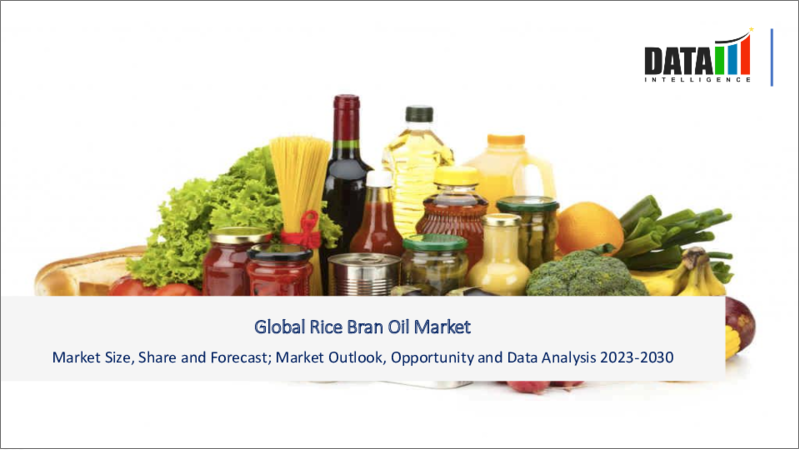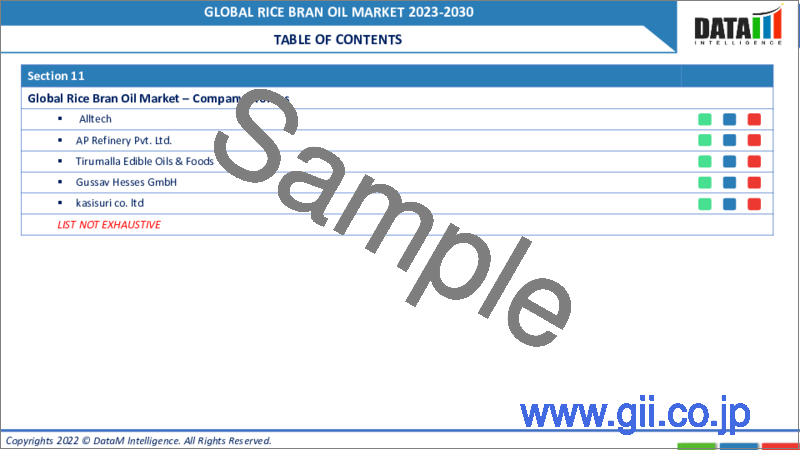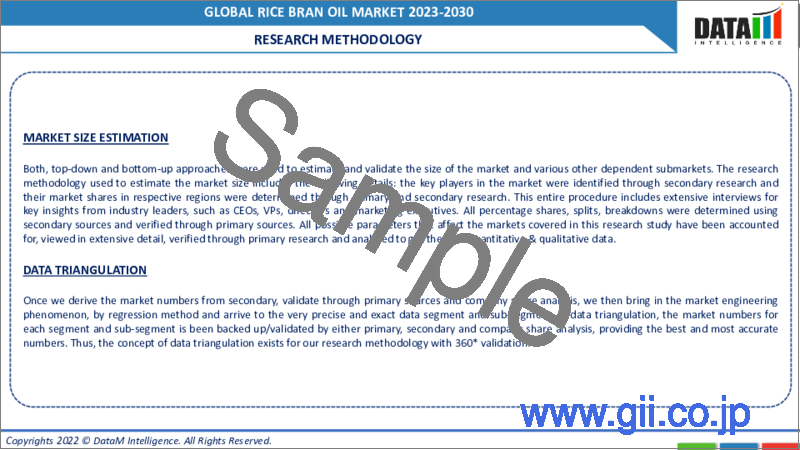|
|
市場調査レポート
商品コード
1179846
米ぬか油の世界市場-2023-2030Global Rice Bran Oil Market - 2023-2030 |
||||||
|
● お客様のご希望に応じて、既存データの加工や未掲載情報(例:国別セグメント)の追加などの対応が可能です。 詳細はお問い合わせください。 |
|||||||
| 米ぬか油の世界市場-2023-2030 |
|
出版日: 2023年01月05日
発行: DataM Intelligence
ページ情報: 英文 170 Pages
納期: 約2営業日
|
- 全表示
- 概要
- 目次
市場力学
米の生産量増加に伴う米ぬか油市場の需要増加
世界の米の生産量の増加により、市場の需要が高まっています。世界的に見ても、この米の生産量増加は米ぬか油市場の収益をエスカレートさせています。インドは世界でも有数の米ぬか油の生産国であり、心臓に優しい油を食生活に取り入れることの重要性を認識する消費者が増加しています。インド政府経済統計総局によると、米の収量は2019年の1ヘクタールあたり2,638キログラムから2020年には2,722キログラムに増加し、市場の成長率をさらに高めているとのことです。
政府は食用油の需給を満たすために、世界中で様々な対策をとっています。さまざまな生産者や投資家が有機食用油の量的制限を解除し、それが米ぬか油市場の成長につながっています。米国農務省によると、2020-21会計年度には、中国、インド、インドネシアが精米生産量の上位を占めました。これらの国々が米ぬか油の生産で高い地位を占めていることにつながります。
しかし、これらの製品の利点についてもっと認識する必要があるため、消費者の間で米ぬか油の採用率は低いです。ひまわり油やオリーブ油など、他の適切な植物油の代替品の存在も市場の成長を妨げ、欧州や北米などの他の地域の消費者の間で採用率が低いという結果につながっています。さらに、高度な生産技術の欠如も、この油の市場での入手性に影響を及ぼしています。これは市場成長を抑制する大きな要因となっています。
目次
第1章 調査手法と範囲
- 調査手法
- 市場の範囲
第2章 主な動向と発展
第3章 エグゼクティブサマリー
- タイプ別市場内訳
- 用途別市場内訳
- 地域別市場内訳
第4章 市場力学
- 市場影響要因
- 促進要因
- 抑制要因
- ビジネスチャンス
- 影響分析
第5章 産業分析
- ポーターのファイブフォース分析
- サプライチェーン分析
- 特許分析
- 規制分析
第6章 COVID-19の分析
- COVID-19の市場に関する分析
- COVID-19以前の市場シナリオ
- COVID-19の現在の市場シナリオ
- COVID-19の後、または将来のシナリオ
- COVID-19の中での価格ダイナミクス
- 需要-供給スペクトラム
- パンデミック時の市場に関連する政府の取り組み
- メーカーの戦略的取り組み
第7章 タイプ別
- リファイン
第8章 用途別
- 食品加工
- 化粧品
- 医薬品
- その他
第9章 地域別
- 北米
- 米国
- カナダ
- メキシコ
- 南米
- ブラジル
- アルゼンチン
- その他の南米地域
- 欧州
- ドイツ
- 英国
- フランス
- スペイン
- イタリア
- その他の欧州地域
- アジア太平洋地域
- 中国
- インド
- 日本
- オーストラリア
- その他アジア太平洋地域
- 中東・アフリカ地域
第10章 競合情勢
- 競合シナリオ
- 競合の戦略分析
- 市況/シェア分析
- M&A(合併・買収)分析
第11章 企業プロファイル
- Cargill Incorporated
- 企業概要
- 製品ポートフォリオと説明
- 主なハイライト
- 財務概要
- Dow
- BASF SE
- Chr. Hansen Holding A/S
- DSM
- DuPont
- Evonik Industries AG
- NOVUS INTERNATIONAL
- Alltech
- Associated British Foods plc
第12章 DataM
Market Overview
The global rice bran oil market was valued at USD YY million in 2022. It is forecasted to reach USD YY million by 2030, growing at a CAGR of 8.34% during the forecast period (2023-2030).
Rice bran oil is prepared by extracting oil from the chaff of the rice. This oil has a high smoke point, making it useful for cooking at high temperatures and a very mild flavor. It is richest in vitamin E, antioxidants, and natural bioactive phytochemicals. It includes oryzanol, tocopherols, tocotrienols, and lecithin. It has a mild flavor and neutral taste. It is extremely versatile and light in texture, with delicate flavors that are suitable for high-temperature cooking and can be easily blended with other less stable oils.
The rice bran oil market has witnessed significant growth due to rising health consciousness among consumers and high demand for nutritional and fat-free food and beverages. Increasing consumer health consciousness from edible oils to reduce cholesterol levels drives the global demand for rice bran oil.
Market Dynamics: Rising demand for rice bran oil market with an increase in the production of rice
The increasing level of rice production worldwide has led to increased market demand. Globally, this rise in rice production has escalated the market revenues in the rice bran oil market. India has been one of the largest producers of rice bran oil globally, with an increasing number of consumers realizing the importance of incorporating heart-friendly oil into their diet. According to the Directorate of Economics and Statistics, the Government of India, the rice yield increased from 2,638 kilograms per hectare in 2019 to 2,722 kilograms per hectare in 2020, further increasing the market's growth.
The government takes various measures worldwide to meet the supply and demand of edible oils. Different growers and investors have lifted the quantitative restrictions on organic edible oils, which has led to the growth of the rice bran oil market. According to the United States Department of Agriculture, China, India, and Indonesia were the top producers of milled rice in the financial year 2020-21. It leads to the high standing of these countries in producing rice bran oil.
However, the adoption of rice bran oil among consumers is low due to the need for more awareness about the benefits of these products. The presence of other suitable vegetable oil substitutes, such as sunflower oil and olive oil, also impedes market growth and results in low adoption among consumers in other regions, such as Europe and North America. Additionally, the lack of advanced production technologies also impacts the availability of this oil in the market. It is a major factor restraining market growth.
Market Segmentation: Refined segment held a highest market revenue share in the year 2021
Refined rice bran-based oil for cooking food products has several health benefits, such as maintaining healthy cholesterol levels and improving heart health. Rice bran-based oil is rich in minerals and proteins, making it a healthier alternative to other edible oils available in the market. Additionally, as per American Heart Association, it helps improve the cholesterol levels in the body. In the U.S., restaurants increase the use of such oil to make new food items.
Furthermore, food and beverage has the largest market share due to the high product usage of various foods and beverages. Mostly in Asian countries, such as India, China, and Japan, oil is used commonly to prepare everyday dishes. The increase in popularity of beverages made of cereal has resulted in increased use of rice bran oil in functional beverages. Rice bran oil is a rich source of vitamin E, gamma-oryzanol, and other components that helps to reduce the cholesterol content in the body and prevent heart disease. Companies are also launching new food products fortified with additional nutrients and vitamins. For instance, in 2021, TSUNO, a Japanese company, launched premium rice bran oil, namely Expeller Pressed Rice Bran Oil, prepared through natural manufacturing.
Geographical Penetration: Asia Pacific the dominating region during the forecast period
Asia-Pacific accounts for a relatively high value share. It is expected to grow significantly in the global rice bran oil market because of the easy availability of raw materials across the region, particularly in India. The major producers in the region are India, China, Japan, and Thailand. India is the world's largest consumption area. The perceived health benefits of cooking in edible oil are one of the primary reasons Australian consumers prefer rice bran oil. It prevents heart attack and helps lower cholesterol absorption. In Japan, this oil is called the 'heart oil' due to its beneficial impact on cardiovascular patients. The rise in disposable income in some emerging economies, such as India and China, further surges the demand for premium healthy food ingredients, including this oil. Most such oil suppliers are available mainly in Asia Pacific countries that export these products to other regions. For instance, in 2021, the Ministry of Consumer Affairs, Government of India launched fortified rice bran oil in India. This rice bran oil was marketed under the apex Agri-marketing organization of India, viz, National Agricultural Cooperative Marketing Federation of India Ltd (NAFED).
Competitive Landscape:
The rice bran oil market is highly competitive and has several small and regional players. The market is fragmented, and the major players include Cargill Incorporated, Dow, BASF SE, and Chr. Hansen Holding A/S, DSM, DuPont, Evonik Industries AG, NOVUS INTERNATIONAL, Alltech and Associated British Foods plc. Emphasis is given to the merger, expansion, acquisition, and partnership of the companies, along with new product development, which work as strategic approaches adopted by the leading companies to boost their brand presence among consumers. Major companies believe in strengthening their product quality with certifications to gain customer loyalty.
For instance, in March 2022, Damdam Rice Drops Balancing Oil Serum was launched in the market. Its composition includes botanical oils such as hydration-retaining rice bran oil and avocado oil as acne-friendly jojoba oil that nourishes the skin for a notable glow. Although it is worn during the day (try a drop or two in your foundation if you wear makeup), we also love it as an overnight mask to top off a more elaborate routine. In June 2021, an India-based company, N.K. Proteins Pvt Ltd. announced its plans to launch the rice bran oil brand 'Tirupati' for health-conscious consumers. It helps enhance immunity, reduces heart disease risk and promotes skin health.
COVID-19 Impact: Negative impact on the global rice bran oil market
The spread of COVID-19 through major ports, cities, and business centers is expected to increase the prices for raw materials in the short and medium run. Also, the worldwide lockdown restricted the supply of raw materials and even the final product in the market. Rice bran oil production and extraction processes was closed in lockdown. Hence the COVID-19 implications declined the amount of stock and revenue in the global industry. The supply chains for raw materials and distribution channels for finished goods have been disrupted due to the prevailing lockdown in most regions. It hindered the pace of market growth and performance.
The global rice bran oil market report would provide access to approximately 61 market data tables, 55 figures and 170 pages
Table of Contents
1. Scope and Methodology
- 1.1. Research Methodology
- 1.2. Scope of the Market
2. Key Trends and Developments
3. Executive Summary
- 3.1. Market Snippet by Type
- 3.2. Market Snippet by Application
- 3.3. Market Snippet by Region
4. Market Dynamics
- 4.1. Market impacting factors
- 4.1.1. Drivers
- 4.1.2. Restraints
- 4.1.3. Opportunities
- 4.2. Impact analysis
5. Industry Analysis
- 5.1. Porter's five forces analysis
- 5.2. Supply Chain Analysis
- 5.3. Patent Analysis
- 5.4. Regulatory Analysis
6. COVID-19 Analysis
- 6.1. Analysis of Covid-19 on the Market
- 6.1.1. Before COVID-19 Market Scenario
- 6.1.2. Present COVID-19 Market Scenario
- 6.1.3. After COVID-19 or Future Scenario
- 6.2. Pricing Dynamics Amid Covid-19
- 6.3. Demand-Supply Spectrum
- 6.4. Government Initiatives Related to the Market During the Pandemic
- 6.5. Manufacturers Strategic Initiatives
7. By Type
- 7.1. Introduction
- 7.1.1. Market size analysis, and y-o-y growth analysis (%), By Type Segment
- 7.1.2. Market attractiveness index, By Type Segment
- 7.2. Refined*
- 7.2.1. Introduction
- 7.2.2. Market Size Analysis, US$ Million, 2020-2029 And Y-O-Y Growth Analysis (%), 2021-2029
8. By Application
- 8.1. Introduction
- 8.1.1. Market size analysis, and y-o-y growth analysis (%), By Application Segment
- 8.1.2. Market attractiveness index, By Application Segment
- 8.2. Food Processing*
- 8.2.1. Introduction
- 8.2.2. Market Size Analysis, US$ Million, 2020-2029 And Y-O-Y Growth Analysis (%), 2021-2029
- 8.3. Cosmetics
- 8.4. Pharmaceuticals
- 8.5. Others
9. By Region
- 9.1. Introduction
- 9.1.1. Market Size Analysis, And Y-O-Y Growth Analysis (%), By Region
- 9.1.2. Market Attractiveness Index, By Region
- 9.2. North America
- 9.2.1. Introduction
- 9.2.2. Key region-specific dynamics
- 9.2.3. Market Size Analysis, And Y-O-Y Growth Analysis (%), By Type
- 9.2.4. Market Size Analysis, And Y-O-Y Growth Analysis (%), By Application
- 9.2.5. Market Size Analysis, And Y-O-Y Growth Analysis (%), By Country
- 9.2.5.1. U.S.
- 9.2.5.2. Canada
- 9.2.5.3. Mexico
- 9.3. South America
- 9.3.1. Introduction
- 9.3.2. Key Region-Specific Dynamics
- 9.3.3. Market Size Analysis, And Y-O-Y Growth Analysis (%), By Type
- 9.3.4. Market Size Analysis, And Y-O-Y Growth Analysis (%), By Application
- 9.3.5. Market Size Analysis, And Y-O-Y Growth Analysis (%), By Country
- 9.3.5.1. Brazil
- 9.3.5.2. Argentina
- 9.3.5.3. Rest of South America
- 9.4. Europe
- 9.4.1. Introduction
- 9.4.2. Key Region-Specific Dynamics
- 9.4.3. Market Size Analysis, And Y-O-Y Growth Analysis (%), By Type
- 9.4.4. Market Size Analysis, And Y-O-Y Growth Analysis (%), By Application
- 9.4.5. Market Size Analysis, And Y-O-Y Growth Analysis (%), By Country
- 9.4.5.1. Germany
- 9.4.5.2. U.K.
- 9.4.5.3. France
- 9.4.5.4. Spain
- 9.4.5.5. Italy
- 9.4.5.6. Rest of Europe
- 9.5. Asia Pacific
- 9.5.1. Introduction
- 9.5.2. Key Region-Specific Dynamics
- 9.5.3. Market Size Analysis, And Y-O-Y Growth Analysis (%), By Type
- 9.5.4. Market Size Analysis, And Y-O-Y Growth Analysis (%), By Application
- 9.5.5. Market Size Analysis, And Y-O-Y Growth Analysis (%), By Country
- 9.5.5.1. China
- 9.5.5.2. India
- 9.5.5.3. Japan
- 9.5.5.4. Australia
- 9.5.5.5. Rest of Asia Pacific
- 9.6. Middle East and Africa
- 9.6.1. Introduction
- 9.6.2. Key Region-Specific Dynamics
- 9.6.3. Market Size Analysis, And Y-O-Y Growth Analysis (%), By Type
- 9.6.4. Market Size Analysis, And Y-O-Y Growth Analysis (%), By Application
10. Competitive Landscape
- 10.1. Competitive scenario
- 10.2. Competitor strategy analysis
- 10.3. Market positioning/share analysis
- 10.4. Mergers and acquisitions analysis
11. Company Profiles
- 11.1. Cargill Incorporated *
- 11.1.1. Company Overview
- 11.1.2. Product Portfolio and Description
- 11.1.3. Key Highlights
- 11.1.4. Financial Overview
- 11.2. Dow
- 11.3. BASF SE
- 11.4. Chr. Hansen Holding A/S
- 11.5. DSM
- 11.6. DuPont
- 11.7. Evonik Industries AG
- 11.8. NOVUS INTERNATIONAL
- 11.9. Alltech
- 11.10. Associated British Foods plc
12. DataM
- 12.1. Appendix
- 12.2. About us and services
- 12.3. Contact us




